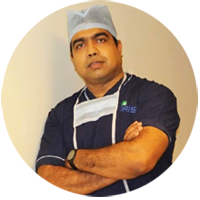Colorectal Cancer
Cancer that develops in the large intestine. Colon cancer refers to cancer that develops in the colon, the longest part of the large intestine. Rectal Cancer develops in the rectum, the final straight part of the large intestine that ends in the anus.
Colorectal cancer is more frequent in men than in women.Most patients with colorectal cancer are more than 60 years old at the time of the diagnosis, and colorectal cancer below the age of 40 years is rare

The main risk factors of Colorectal Cancer are:
• Aging: the risk of colorectal cancer increases as a person gets older.
• Lifestyle-related risk factors
- Diet: diet is the most important environmental risk factor for colorectal cancer. A diet that is high in red meat and processed meat, high in fat and/or low in fiber can increase the risk of developing colorectal cance
- High consumption of alcohol
- Obesity: overweight increases the risk of developing colorectal cancer
- Sedentary lifestyle
- Smoking
• Diabetes mellitus type 2 increases the risk of developing a tumour in the large intestine.
• Previous history of colorectal polyps
• Previous history of colorectal cancer
• Inflammatory bowel disease such as Crohn’s disease or ulcerative colitis
• Family history: approximately 20 % of colorectal cancers occur in a familial context
Colorectal cancer causes complaints more often when it is advanced. Common symptoms are change in bowel habits, abdominal discomfort, fatigue, weight loss. Blood in stools could be a sign of alert. It could be visible to the naked eye or through a laboratory analysis of stools.
Endoscopy is an examination in which a lighted tube is inserted through the anus into the intestine. It allows seeing the inside of the intestine. When a tumour is found within 15 cm from the anus it is considered rectal tumour, further away it is considered colon tumour.
Special Radiological Tests also help to visualize the localisation and size of the tumour.
Blood analysis looking for Carcinoembryogenic Antigen (CEA), a tumour marker, might be useful in selected situations.
The confirmation of diagnosis is only given by laboratory analysis of the tumour and tissues affected (histopathology).
Treatment Options:
Planning of the treatment involves an interdisciplinary team* of medical professionals. This usually implies a meeting of different specialists, called multidisciplinary opinion.
The treatment will usually combine therapies that:
• Act on the cancer locally, such as surgery or radiotherapy
• Act on the cancer cells systemically (all over the body) such as chemotherapy and biological targeted therapy.
The extent of the treatment will depend on the stage of the cancer, on the characteristics of the tumour and on the risks for the patient.
Surgery:
Surgery aims to remove the primary tumour. In patients with advanced disease, surgery may also be performed to remove metastatic lesions.
Standardized resections are now considered more appropriate than segmental resections in the treatment of colon cancer. Depending on the location of the tumour, such standardized resection consists of removing either the ascending colon (right hemicolectomy) or the descending colon (left hemicolectomy) or the sigmoid colon (sigmoid resection). Right and left hemicolectomy are sometimes extended to the transverse colon and are then called extended (right or left) hemicolectomy*. The corresponding segment of the bowel is removed as well as the regional lymph nodes* and any part of the adjacent organs that are invaded by the tumour.In the case of rectal cancer the entire rectum, along with the mesorectum containing the regional lymph node is removed, the procedure is called Total Mesorectal Excision (TME).
Surgical resections can be performed by laparotomy, but also by laparoscopy. Laparotomy refers to open surgery, meaning that the surgeon makes a large incision in the abdomen to perform the operation. During laparoscopy, fine lighted tubes and instruments are inserted through 3 or 4 small holes in the abdomen. After laparoscopy, patients experience a quicker and easier recovery then after laparotomy


